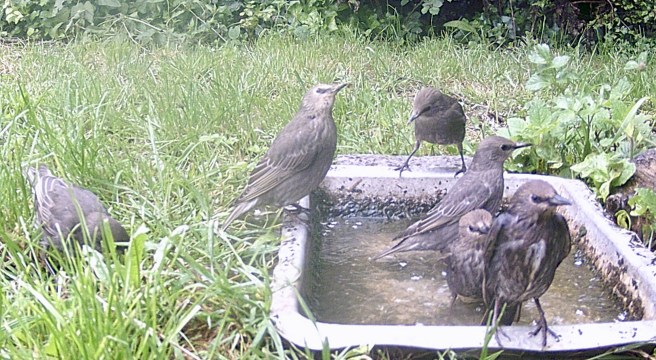
There was a very concerning weather forecast for our daughter’s wedding last weekend but in the event we were lucky. The reception was in a marquee on our lawn but there was a magical little bar set up in the meadows that worked so well towards the end of the evening. With only thirty of us, it was a small but perfectly formed and joyous celebration to launch them on their married lives together.

But as a result of all this celebrating, we have once again missed this year’s Green Woodpecker fledging in the wood and this photo is the best that I can offer you:

We actually did quickly nip to the wood the night before the wedding but found the birds had already left the nest, although we could still hear them nearby. We did, however, find this dead Mole:


I didn’t know much about Moles and so I have read up about them. They have a system of permanent deep burrows forming a network that is hundreds of metres long with tunnels at different depths, the deeper ones being used during droughts and when it is cold. Many generations of mole will use these permanent tunnels to find their earthworm prey, which they store alive but immobilised in chambers.
In the wood, the Moles will be predated by Tawny Owls, Buzzards and Stoats and the young ones are particularly vulnerable as they disperse away from their mother’s range above ground during the summer. I wonder if this dead Mole is a dispersing youngster, although that doesn’t explain why it hasn’t been eaten.

Other photos from the wood:






Crows have fledged in the meadows as well:

There is a flock of about forty young Starlings now working the meadows:



And a young Stock Dove on the left:

After all the recent rain, the ponds continue to look really full and healthy – unprecedented for late June.

We found a Sparrowhawk kill up on the strip. There was still much meat on the bones and so we put a camera on it in case the Sparrowhawk came back.

But it was the Crows and Magpies that arrived to peck over the carcass


But, unexpectedly, a House Sparrow also came to gather up some of the feathers.

Yellow Rattle is parasitic on grass and helps knock it back, giving meadow flowers more of a chance to thrive. Three or four autumns ago we sowed a test area with Yellow Rattle seed as a bit of an experiment. It is far too densely planted but there is no disputing that the grass has been disadvantaged and the area can now function as a seed bank for the rest of the meadows.

We got the tractor out to cut a section of the first meadow to become a car park for the wedding weekend:

The tractor shaves off the tops of any anthills, creating bare earth patches into which new plants can get a hold. Now that the Yellow Rattle has finished flowering in the test area, we collected some of the seed to spread over this newly cut section.

Although we have planned to collect and spread this seed for several years, this is the first time we have got round to actually doing it and it feels good.
Last autumn I planted Sweet William in the allotment to use as cut flowers. These are old fashioned plants but they have been fantastic and I have been cutting them for months now to put into jam jars to bring in to the house.


One afternoon this week I was picking some strawberries in the allotment and saw a Hummingbird Hawk-moth on the Sweet William. I ran for my camera but this is the best that I could achieve before it flew away:

I had already decided to plant more Sweet William this autumn but now that I know that Hummingbird Hawk-moths like it, I shall certainly be growing some every year.
A gathering with the correct two metre distancing at peanut time:

Here are the two vixens that have had cubs this year. They seem very comfortable together and are presumably part of a family group:





Some other photos from the meadows:




















This photo of a Kestrel with a mouse in his large yellow feet reminded us that we had taken our eye off the ball down at our local white cliffs:

We went down this week to take a look:

Perhaps the Kestrel hunting in the meadows is the father of these chicks?

A bit further along, there were two adult Peregrines perched near their nest high on the cliffs:

We stopped to watch a recently fledged family of Whitethroat:




I finish today with mating Hedgehogs on our son’s lawn in Berkshire. Previously unaware that he even had Hedgehogs, he now hopes to raise awareness amongst his neighbours and perhaps they might even be persuaded to set up a Hedgehog highway network within the gardens so that the Hedgehogs can get in to forage. These animals are in such desperate trouble that they need any help they can get.


Sensational photos as usual Judy.
What a wonderful habitat you have both created on your land.
It surely is “All creatures great & small” 👏👏👏
So much to see in your post. Looks wonderful. It sounds like the wedding was lovely too. I love the pyramid orchids, they are so colourful. Found a bee orchid today in the quarry area of a nature reserve in Clitheroe. Always a treat to see. X
I love bee orchids too – very special plants indeed x